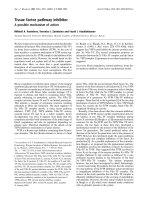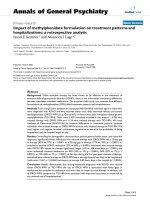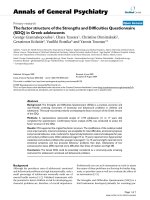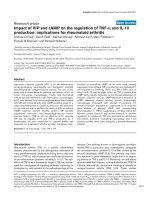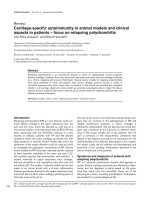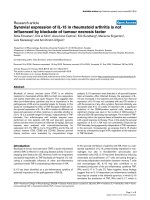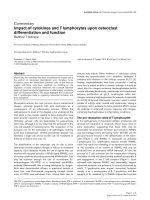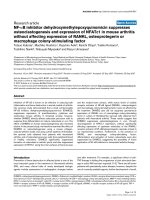Báo cáo y học: " Impact factor, H index, peer comparisons, and Retrovirology: is it time to individualize citation metrics?" ppsx
Bạn đang xem bản rút gọn của tài liệu. Xem và tải ngay bản đầy đủ của tài liệu tại đây (225.29 KB, 4 trang )
BioMed Central
Page 1 of 4
(page number not for citation purposes)
Retrovirology
Open Access
Editorial
Impact factor, H index, peer comparisons, and Retrovirology: is it
time to individualize citation metrics?
Kuan-Teh Jeang*
Address: National Institutes of Health, Bethesda, MD, USA
Email: Kuan-Teh Jeang* -
* Corresponding author
Abstract
There is a natural tendency to judge a gift by the attractiveness of its wrapping. In some respect,
this reflects current mores of measuring the gravitas of a scientific paper based on the journal cover
in which the work appears. Most journals have an impact factor (IF) which some proudly display on
their face page. Although historically journal IF has been a convenient quantitative shorthand, has
its (mis)use contributed to inaccurate perceptions of the quality of scientific articles? Is now the
time that equally convenient but more individually accurate metrics be adopted?
I surmise that a common question posed to an editor of a
new journal is "What is your impact factor?" Based on my
experience, in the majority of instances as the conversa-
tion evolves, it becomes evident that the questioner mis-
understands what impact factor means. IF is a useful
number. However, its limitations must be clearly recog-
nized. Given the pervasive (if not obsessive) interest in IF,
Retrovirology, as a new journal entering its fourth year of
publication, has necessarily mined the citation databases
and calculated IF numbers for 2005 (2.98) and 2006
(4.32) [1]. After having captured those numbers, it is per-
haps instructive to consider some factual denotations and
frequently misinterpreted connotations of IF. Indeed, as
science and medicine march to a more personalized
approach, one might further ask if it is time to embrace
highly accessible technology in order to complement/sup-
plant generic IF with individually precise citation metrics?
Impact Factor what does it (not) say?
In the 1960s, the Institute for Scientific Information (ISI),
a component of Thomson Scientific, a division of The
Thomson Corporation (a publicly traded company
engaged in financial services, healthcare sectors, law, sci-
ence and technology research, and tax and accounting
services) devised the "impact factor" (IF), a number devel-
oped for the purpose of comparing different journals [2].
IF gauges the standing of a journal for a specified year.
Hence, IF can be viewed as the mean number of citations
that occurred in a specific year to articles published in a
journal during the two previous years. In common vernac-
ular, IF reflects the number of times an "average article" in
a journal has been cited per year in the two immediately
preceding years. A poorly-understood nuance to this defi-
nition is that IF disproportionately favors citations made
during the first two years subsequent to a paper's publica-
tion, and does not accurately capture the paper's "value"
over a longer time. Hypothetically, let's consider two
papers that receive the same total number of citations (e.g.
100 times) over a 10 year period. Paper A is cited 80 times
in its first two immediate calendar years after publication,
and then 20 times over the subsequent eight years. Paper
B is cited 20 times over the first two years and 80 times
over the next eight years. Paper A fits the profile of an aver-
Published: 18 June 2007
Retrovirology 2007, 4:42 doi:10.1186/1742-4690-4-42
Received: 15 June 2007
Accepted: 18 June 2007
This article is available from: />© 2007 Jeang; licensee BioMed Central Ltd.
This is an Open Access article distributed under the terms of the Creative Commons Attribution License ( />),
which permits unrestricted use, distribution, and reproduction in any medium, provided the original work is properly cited.
Retrovirology 2007, 4:42 />Page 2 of 4
(page number not for citation purposes)
age article published by the journal "FlashyStuff"; while
paper B is a usual paper in the journal "ReliablySolid".
Within the context of this example, FlashyStuff would
sport an IF of 40 while ReliablySolid would have an IF of
10. Intriguingly, the rather impressive 4 fold difference in
impact factor belies common sense that over ten years,
a FlashyStuff article is cited no more frequently than a Reli-
ablySolid paper (both exactly 100 times).
The above discussion briefly spotlights what IF in part
does and does not convey. With that disclaimer, how is
Retrovirology doing IF-wise as the journal enters its fourth
year? Employing the algorithm that IF derives from the
number of citations to a journal (by other ISI tracked jour-
nals) divided by the "citable items" published in the jour-
nal, in 2005 Retrovirology had a calculated IF of 2.98 based
on ISI data. For 2006, Retrovirology's IF is calculated using
the following parameters : N (numerator) = the number of
times Retrovirology articles published in 2004 and 2005
were cited by other journals during the single 2006 year,
and D (denominator) = the total number of citable Retro-
virology articles published in years 2004 and 2005. Retrovi-
rology's 2006 IF is then N divided by D = 4.32.
How does 4.32 stack up against numbers from other jour-
nals? Figure 1 compares Retrovirology's 4.32 IF with recent
IF numbers of other virology journals that frequently pub-
lish basic research on retroviruses. When measured
against Journal of Virology, Journal of General Virology, Virol-
ogy, Current HIV Research, AIDS Research and Human Retro-
viruses, and Intervirology, Retrovirology, the only Open
Access publication amongst the seven, indeed rates very
competitively (Fig. 1).
Now for something completely different?
In the late 1970's when I began graduate school, large
bulky word processing machines were just being invented,
and small personal computers did not exist. This was a
period when if one wished to learn what was being pub-
lished, one had to reach for the weekly/monthly periodi-
cals (that often meandered through the postal service
sometimes, if it is a foreign journal, arriving months after
publication) which were displayed on reading shelves in
libraries. PubMed, other electronic databases, email, key-
word e-alert, and instant table of contents notification
were science fiction. In that era, it was laborious and time
consuming to assess individually a journal's or a col-
league's citation records. Hence, back then, judging a
"book by its cover" or rating a paper based on the jour-
nal's IF would seem excusable simply because there was
little other practical recourse.
In 2007, one can do much better. In the fifty years since
the advent of IF, a couple of salient shortcomings to this
index have been noted. First, an inherent quirk to IF defi-
nition allows the numerator to contain citations to "non-
citable" items that are not counted in the denominator
[3]. In general, "non-citable" items are the short newsy/
opinion/commentary "front matter" pieces written by
professional writers which appear frequently in many
"high impact" journals. Citations to "front matter" pieces
are tallied in the numerator for a journal's IF without a
commensurate "penalty" added to the denominator.
Hence, venues that publish numerous "non-citable" front
matters have "inflated" IFs relative to counterparts that
publish only "citable" articles (e.g. original research
papers). Second, a journal's IF is a poor surrogate indica-
tor of individual articles published in that journal. There
is a statistical pattern to citations that on average 15% of
the articles in a journal accounts for 50% of all citations to
that journal, and the top 50% of articles in a journal gar-
ner 90% of citations to that journal [4]. Thus, a top 50%
article can be cited 10 times more frequently than a bot-
tom 50% article in the same journal [4]. Given the likeli-
hood of a 10 fold difference in actual citations, why
should colleagues assume that one Cell/Science/Nature
paper has remotely the same value as another? Hence,
even if one accepts citation frequency as a reflection of
quality, there is little reason to adopt a journal's overall IF
as a reliable touchstone for the gamut of papers published
in that journal. The umbrella-like use of IF as a general
quality tag seems all the more unnecessary since there are
so many rapid and accessible options for tracking article-
specific citations (e.g. Google Scholar, Scopus, and Web of
Science [5]).
A couple of days ago, I read a remarkable news headline.
"James Watson of DNA fame gets his own genome map".
I recollected that when the first human genome sequenc-
ing was being done generic anonymity of that initial DNA
A comparison of Retrovirology's calculated 2006 impact factor with selected journals that publish retrovirus research papersFigure 1
A comparison of Retrovirology's calculated 2006 impact factor
with selected journals that publish retrovirus research
papers. Values for other journals are from ISI journal citation
report for 2005.
-RXUQDO
/DWHVW,)
-RXUQDORI9LURORJ\
5HWURYLURORJ\
9LURORJ\
-RXUQDORI*HQ9LURORJ\
&XUUHQW+,95HVHDUFK
$,'65HV+XPDQ5HWUR
,QWHUYLURORJ\
5HWURYLURORJ\,)FDOFXODWHGDVGHVFULEHGFRPSDUHGWR,)IRU
2WKHUVIURP,6,ZHERIVFLHQFH
Retrovirology 2007, 4:42 />Page 3 of 4
(page number not for citation purposes)
was important. However, time has changed, and today
James Watson (and you too) can have an individual
genome sequenced rapidly and inexpensively. Is now not
also the time that scientists should move to personalized
measurements of citations? Aren't individual citation fre-
quencies more thoughtful reflections of one's scientific
corpus than the answer to the oft-bantered generic query
"How many Cell/Science/Nature papers has he/she pub-
lished?"
Today, one's individual citation frequency is easily acces-
sible to all who have a few minutes to spend and internet
access to databases. Google Scholar, Scopus, or Web of
Science can each fully provide such information. Of the
three, I found Scopus [6] to be the most user-friendly in its
data organization and searchability. Hence, yesterday
when I had a spare hour, I used Scopus to tabulate indi-
vidual citation frequency and H index of 45 members of
Retrovirology's editorial board (Table 1). {The H index is
Table 1: Citation frequency and H index for selected Retrovirology Editorial Board members (data collated on June 11, 2007 from
Scopus).
Title Name Role within
Retrovirology
Institution City Country H index Total times
cited
since 1995
Dr. Kuan-Teh Jeang Editor-in-Chief NIH Bethesda USA 39 7724
Dr. Monsef Benkirane Editor CNRS Montpellier France 15 1371
Dr. Ben Berkhout Editor Academic Med. Ctr Amsterdam the Netherlands 32 4627
Dr. Andrew Lever Editor Cambridge University Cambridge UK 16 1591
Dr. Mark Wainberg Editor McGill University Montreal Canada 34 8457
Dr. Masahiro Fujii Editor Niigata University Niigata Japan 18 1410
Dr. Michael Lairmore Editor Ohio State University Columbus USA 17 1721
Dr. Michael Bukrinsky Ed Board George Washington Univ Washington DC USA 21 4247
Dr. Dong-yan Jin Ed Board Hong Kong U Hong Kong China 20 1896
Dr. Klaus Strebel Ed Board NIH Bethesda USA 21 3218
Dr. Tom J. Hope Ed Board U. Illinois Chicago USA 23 3609
Dr. Serge Benichou Ed Board Cochin Institute Paris France 20 1466
Dr. Stephane Emiliani Ed Board Cochin Institute Paris France 15 1506
Dr. Olivier Bensaude Ed Board INSERM Paris France 20 2046
Dr. Mauro Giacca Ed Board Int. Ctr. Genetics Trieste Italy 33 4577
Dr. Olivier Schwartz Ed Board Institut Pasteur Paris France 26 3865
Dr. Leonid Margolis Ed Board National Inst Child Health Bethesda USA 17 1394
Dr. Fatah Kashanchi Ed Board George Washington U. Washington DC USA 24 2071
Dr. Masao Matsuoka Ed Board Kyoto University Kyoto Japan 19 1554
Dr. Naoki Mori Ed Board University of the Ryukyus Okinawa Japan 24 1727
Dr. Chou-Zen Giam Ed Board Uniform Services Med Sch Bethesda USA 14 1288
Dr. David Derse Ed Board NCI Frederick USA 12 1488
Dr. Tatsuo Shioda Ed Board Osaka Univ Osaka Japan 21 1605
Dr. John Semmes Ed Board Eastern Virginia Med College Norfolk USA 23 2230
Dr. John Hiscott Ed Board McGill Univ. Montreal Canada 37 6134
Dr. Fabrizio Mammano Ed Board INSERM Paris France 14 1485
Dr. James K. Hildreth Ed Board Meharry Univ. Nashville USA 23 2305
Dr. Finn Skou Pedersen Ed Board University of Aarhus Aarhus Denmark 17 1169
Dr. Janice Clements Ed Board Johns Hopkins Med School Baltimore USA 21 2879
Dr. Tahir A. Rizvi Ed Board United Arab Emirates Univ. Al Ain UAE 14 1133
Dr. Chris Aiken Ed Board Vanderbilt University Nashville USA 15 1593
Dr. Neil Almond Ed Board NIBSC Potters Bar UK 12 1132
Dr. Stephen P. Goff Ed Board Columbia University New York USA 33 8325
Dr. Johnson Mak Ed Board Burnet Inst. Med. Research Victoria Australia 14 1094
Dr. Christine Kozak Ed Board NIH Bethesda USA 27 6967
Dr. Greg Towers Ed Board Univ. College London UK 14 1047
Dr. Graham Taylor Ed Board Imperial College London UK 20 1710
Dr. Eric Cohen Ed Board Univ. Montreal Montreal Canada 31 5050
Dr. William Hall Ed Board University College Dublin Dublin Ireland 16 1293
Dr. Warner Greene Ed Board UCSF San Francisco USA 35 8114
Dr. Jean-luc Darlix Ed Board U. Lyon Lyon France 27 4816
Dr. Axel Rethwilm Ed Board U. Wuerzburg Wuerzburg Germany 21 1784
Dr. Eric Freed Ed Board NCI Frederick USA 27 3495
Dr. Toshiki Watanabe Ed Board Univ. of Tokyo Tokyo Japan 18 1276
Dr. Mari Kannagi Ed Board Tokyo Med and Dental U Tokyo Japan 14 1189
Publish with BioMed Central and every
scientist can read your work free of charge
"BioMed Central will be the most significant development for
disseminating the results of biomedical research in our lifetime."
Sir Paul Nurse, Cancer Research UK
Your research papers will be:
available free of charge to the entire biomedical community
peer reviewed and published immediately upon acceptance
cited in PubMed and archived on PubMed Central
yours — you keep the copyright
Submit your manuscript here:
/>BioMedcentral
Retrovirology 2007, 4:42 />Page 4 of 4
(page number not for citation purposes)
another way to quantify a scientist's quality and quantity
of scholarly output [7,8]. This index attempts to combine
and balance the effect of "quantity" (number of publica-
tions) and "quality" (citation rate) in a specific way.} I
should point out that I did this data collection quickly
(each person's numbers took no more than 1 minute),
and as with all databases and human entries there can be
errors (apologies to colleagues if I made mistakes with
your numbers). Hence, please take table 1 to be illustra-
tive rather than factually literal. Nevertheless, this elemen-
tary exercise echoes the words of a past US president, "You
can run, but you cannot hide." Like it or not, use it or not,
each author's personalized citation number and H index
are there for all to compare.
Gilt by association?
How then should one choose where to publish one's
manuscript? It has been raised that many scientists
employ the "gilt by association" [9] approach, first send-
ing their papers to high-visibility, high-IF journals, per-
haps hoping that the "free ride" hypothesis works [4] and
some of a journal's sheen would direct attention to and
rub off on the work. However, there is no factual evidence
that publishing a paper in a highly touted journal adds
"free citations" to a paper other than those achieved by its
content [4]. Indeed, this point seems to make intuitive
sense. For example, a paper is the same paper if it were ini-
tially declined at Cell and then published in the Journal of
Virology than if the paper were quickly accepted at Cell and
did not have to make the rounds to the Journal of Virology.
If the paper remains the same, should one sequence of
events confer higher inherent quality to the same paper
over another?
In the past, to support the interest of equal access to
knowledge by scientists and students in developing econ-
omies who cannot afford subscription-based journals, I
have argued that we have a responsibility to support Open
Access publishing [10]. From a principled point of view,
not to do so is poorly defensible. On the other hand, if
one formulates decisions using a self-interest citation fre-
quency driven perspective, evidence similarly supports
that in head-to-head comparisons Open Access articles are
cited more frequently than non-Open Access counterparts
[11]. In today's publishing world, there are important
roles to be played by both subscription and Open Access
journals. However, as Open Access journals ascend in
quality and visibility and globalization brings us closer to
previously distant strangers, scientists confident in the
inherent content and value of their papers might ask if
they can tolerate the "guilt associated with not supporting
egalitarian access"?
The above is a difficult question that each individual has
to ponder. I am grateful for the answer that many authors
and editorial board members of Retrovirology have pro-
vided to this question.
Acknowledgements
I thank Ben Berkhout, Andrew Lever, Matt Cockerill and Robert Brumfield
for critical readings of this editorial. The opinions expressed in this editorial
are personal to the author and do not necessarily represent the views of
his employer, the NIH. Work in KTJ's laboratory is funded by intramural
funds from the NIAID, NIH.
References
1. Jeang KT: Retrovirology: 3 at age 2. Retrovirology 2006, 3:30.
2. Garfield E: The history and meaning of the journal impact fac-
tor. JAMA 2006, 295:90-93.
3. Dong P, Loh M, Mondry A: The "impact factor" revisited. Biomed
Digit Libr 2005, 2:7.
4. Segelen PO: Why the impact factor of journals should not be
used for evaluating research. BMJ 1997, 314:498-502.
5. Bakkalbasi N, Bauer K, Glover J, Wang L: Three options for cita-
tion tracking: Google Scholar, Scopus and Web of Science.
Biomed Digit Libr 2006, 3:7.
6. Scopus [ />]
7. Braun T, Glanzel W, Schubert A: A Hirsch-type index for jour-
nals. The Scientist 2005, 19:8.
8. Hirsch JE: An index to quantify an individual's scientific
research output. Proc Natl Acad Sci USA 2005, 102:16569-16572.
9. Grivell L: Through a glass darkly. EMBO Rep 2006, 7:567-570.
10. Jeang KT: Libya, HIV, and open communication. Retrovirology
2006, 3:99.
11. Eysenbach G: Citation advantage of open access articles. PLoS
Biol 2006, 4:e157.
